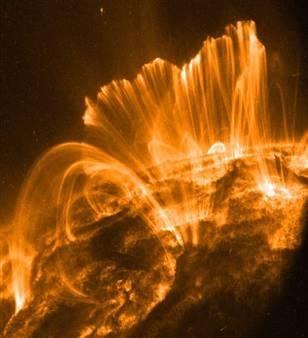The sun's erratic and sometimes volatile behavior has the potential to cause real problems here on Earth, and protecting our planet will require an international effort, according to scientists who gathered recently for a meeting about the effects of solar activity.
Streams of charged particles that fly off the sun can interfere with electronics on Earth and satellites orbiting our planet. For example, during a particularly intense solar storm in 1989, power to an entire Canadian province was knocked out. Since then, other storms have knocked a handful of satellites out of service.
 |
|
A solar eruption, something that is beautiful and dangerous. Streams of charged particles that fly off the sun can interfere with electronics on Earth and satellites orbiting our planet. (Image by NASA) |
With Earth becoming more and more dependent on technology, the risk from solar flares is only going up, experts say.
Facing the risks
Representatives from more than 25 of the world's most technologically-advanced nations convened last week for the International Living with a Star (ILWS) meeting in Bremen, Germany, to discuss the importance of developing better methods for forecasting space weather.
"The problem is solar storms" figuring out how to predict them and stay safe from their effects," said ILWS chairperson Lika Guhathakurta from NASA's Headquarters in Washington, D.C. "We need to make progress on this before the next solar maximum arrives around 2013."
By then, solar storms will be at their strongest and most frequent in the roughly 11-year cycle of the sun's activity, which is just now emerging from an unusually long period of quiescence.
The sun's constant interaction with Earth makes it imperative for solar physicists to keep track of solar activity.
In fact, the sun and Earth are actually connected by invisible threads of magnetism. During so-called "reconnection events," invisible lines of force can be traced all the way from Earth's poles to the surface of the sun. These events typically happen several times a day.
"The Earth and sun are interconnected," Guhathakurta said. "We cannot study them separately anymore."
A league of its ownThe term " heliophysics " is used to describe the science of the sun-Earth system, and the field of study has expanded significantly in the past few years. NASA has a dedicated Heliophysics Division at the agency's headquarters, and the United Nations declared 2007 the "International Heliophysical Year" in hopes of stimulating global involvement.
But, predicting solar activity is an extremely complicated task, and being able to forecast the sun's behavior solves only half of the equation.
Equally important is being able to understand how the Earth's magnetic field and atmosphere respond to any given solar storm, scientists said. So far, this has remained a mystery to top researchers, even with the aid of the most powerful supercomputers. As a result, the ability to track and monitor space weather has severely lagged behind the science of Earth weather.
"We need more data and more ideas," Guhathakurta said.
An international effort
This week, Guhathakurta will hand over her chairmanship of ILWS to WU Ji of the Chinese Academy of Sciences. WU will also spend the next two years cultivating the talents of Chinese heliophysicists.
"We have many scientists and lots of fresh ideas," WU said. "China will be able to make important contributions in this area."
Yet another challenge is the ability to study heliophysics as it plays out across hundreds of millions of miles. NASA and other space agencies have deployed dozens of spacecraft, but they are spread out over an enormous distance.
"Imagine trying to monitor Earth's oceans with a small number of buoys," Guhathakurta said. "You'd miss a lot. That's the situation we're in now with the 'ocean of space.'"
China is preparing to launch a space buoy, known as "KuaFu," which will be located at the L1 Lagrange point a spot where the Earth's and sun's gravity balance out, allowing a satellite to perch there continuously. The probe, which will sample the solar wind upstream from Earth, is named after a giant in Chinese mythology who wished to capture the sun.
"We're putting KuaFu at a strategic point in space," WU said. "The solar wind at L1 is an important input to many science models of the sun-Earth interaction."
KuaFu will join a growing international fleet of spacecraft that are dedicated to heliophysics. NASA, the European Space Agency, the Russian Federal Space Agency, the Canadian Space Agency, and the Japanese Aerospace Exploration Agency have also made significant contributions to the field.
Just in time?
Still, mobilizing an increased international effort could be more important now than ever before, scientists said. If current forecasts are correct, the solar cycle is expected to peak during the years around 2013. While it likely won't be the biggest peak on record, human society is becoming increasingly more vulnerable.
The rituals of daily life from communications to weather forecasting to financial services are highly dependent on satellites and electronics. A 2008 report by the National Academy of Sciences warned that a century-class solar storm could cause billions of dollars in economic damage.
Scientists at the ILWS meeting are hoping to address concerns of such a "solar Katrina" situation, while also determining the best ways to launch new science and harness the talents of heliophysicists around the globe. (Space.com)





